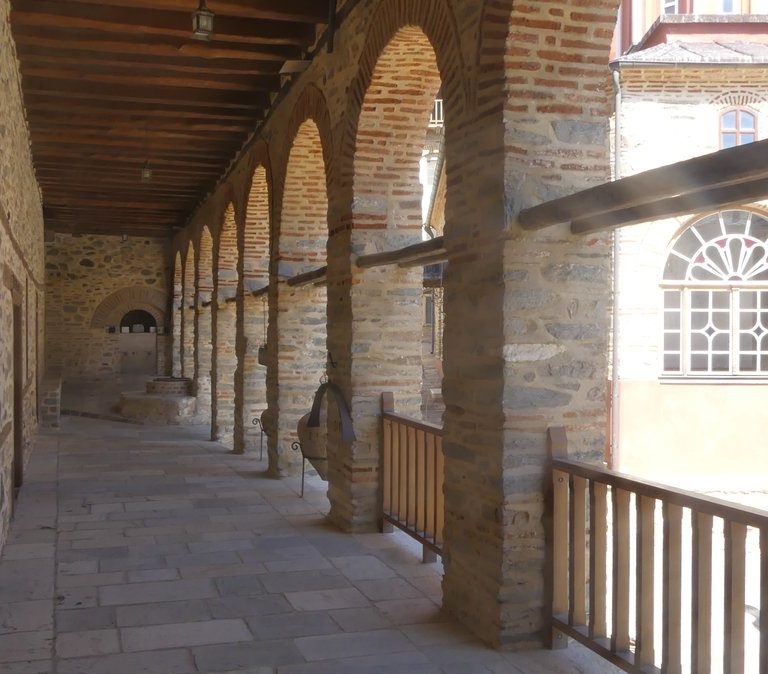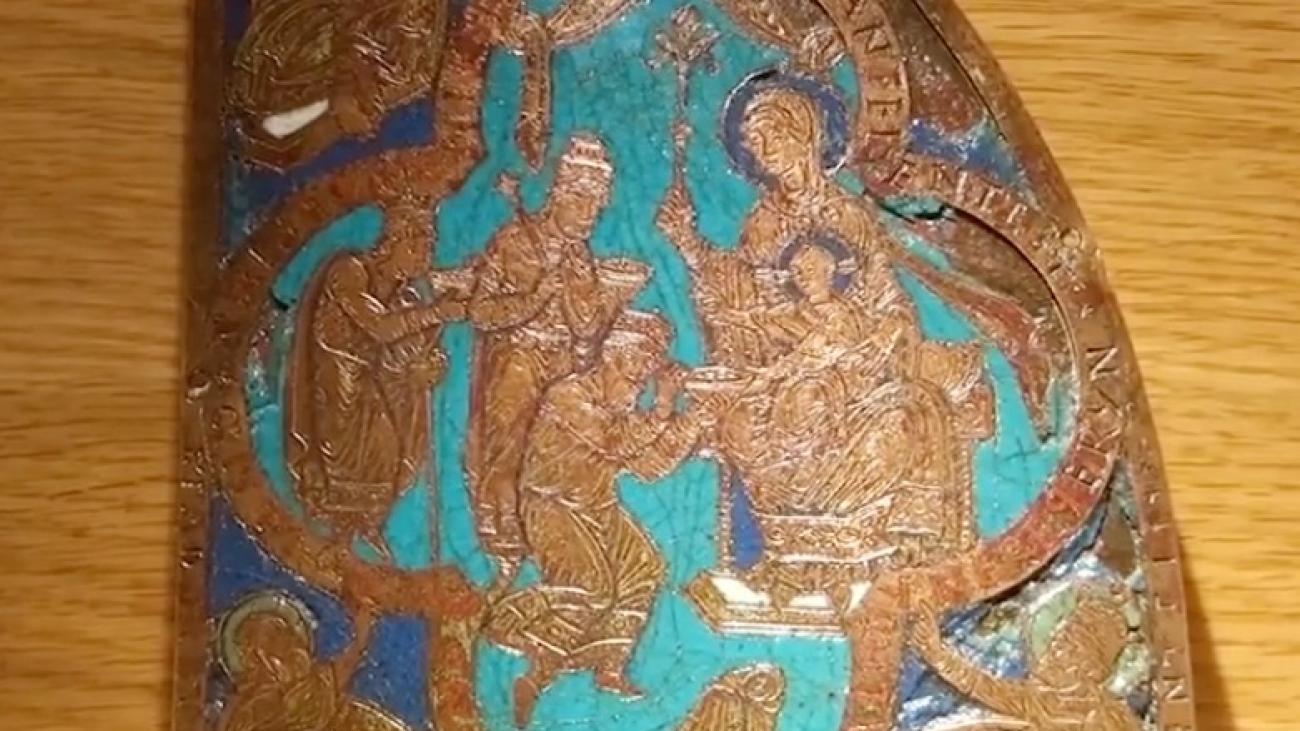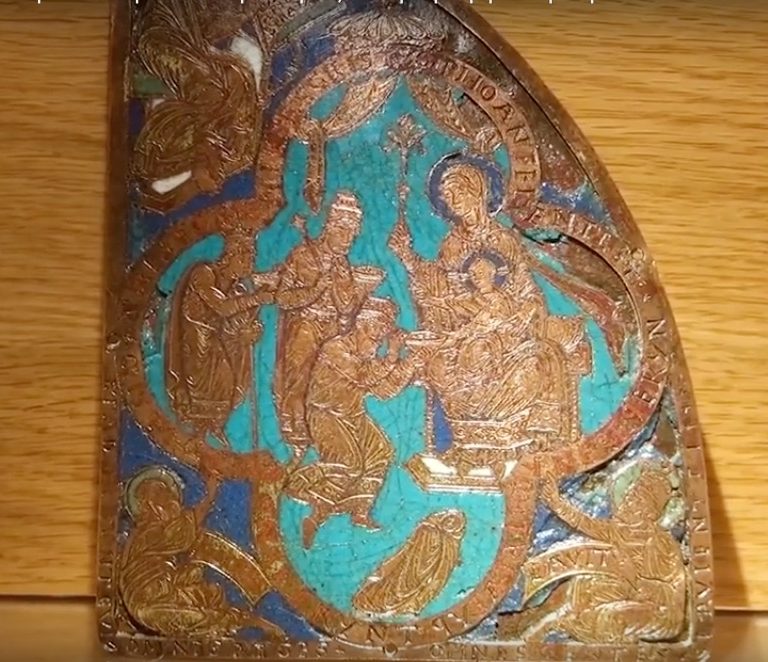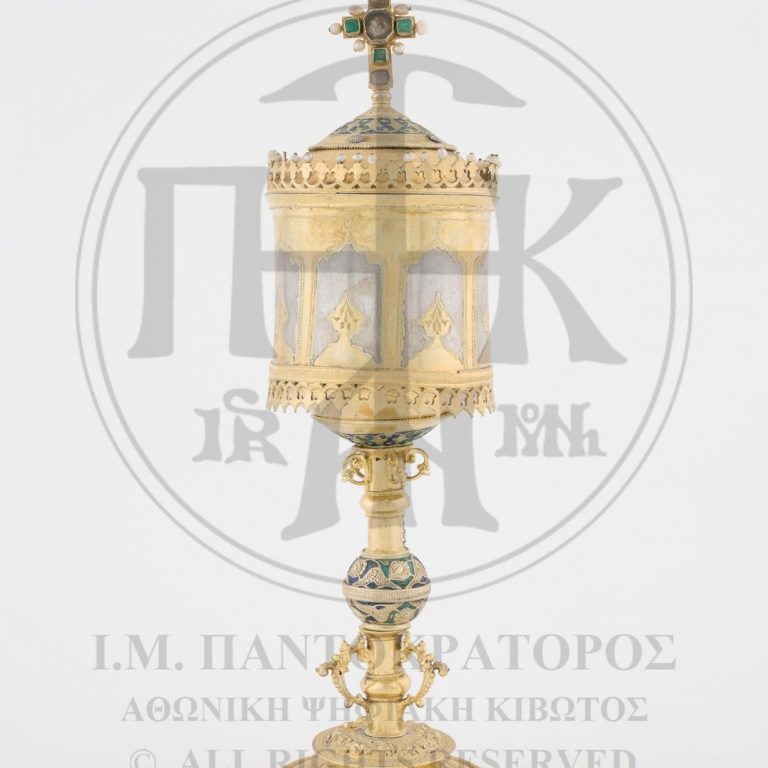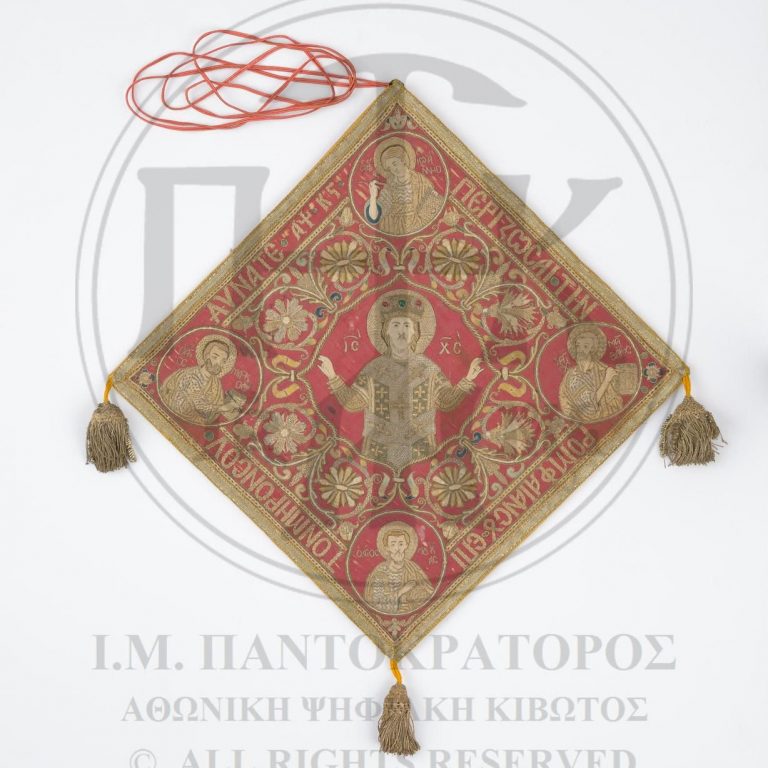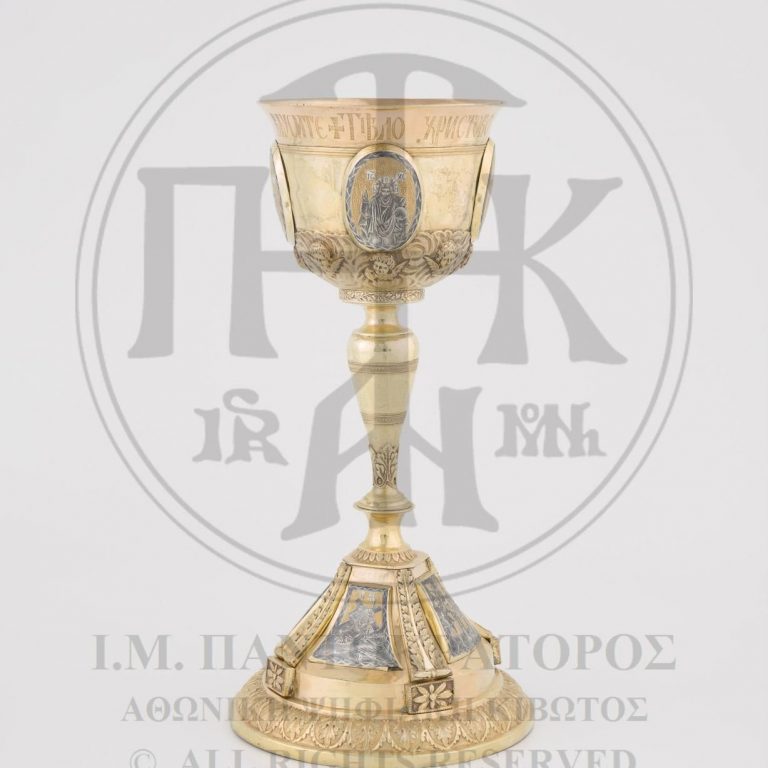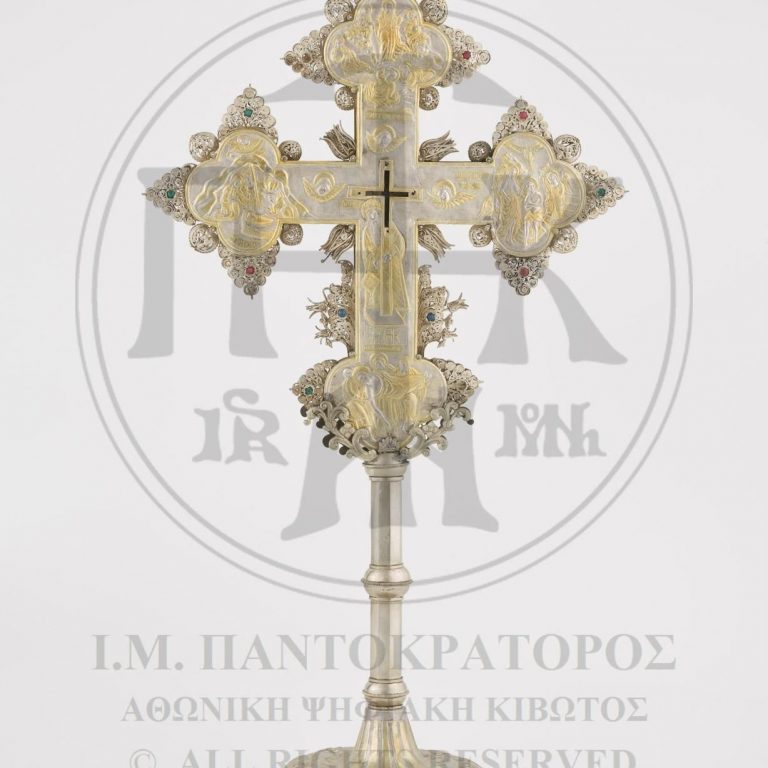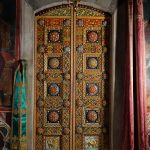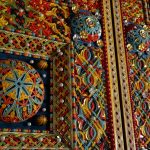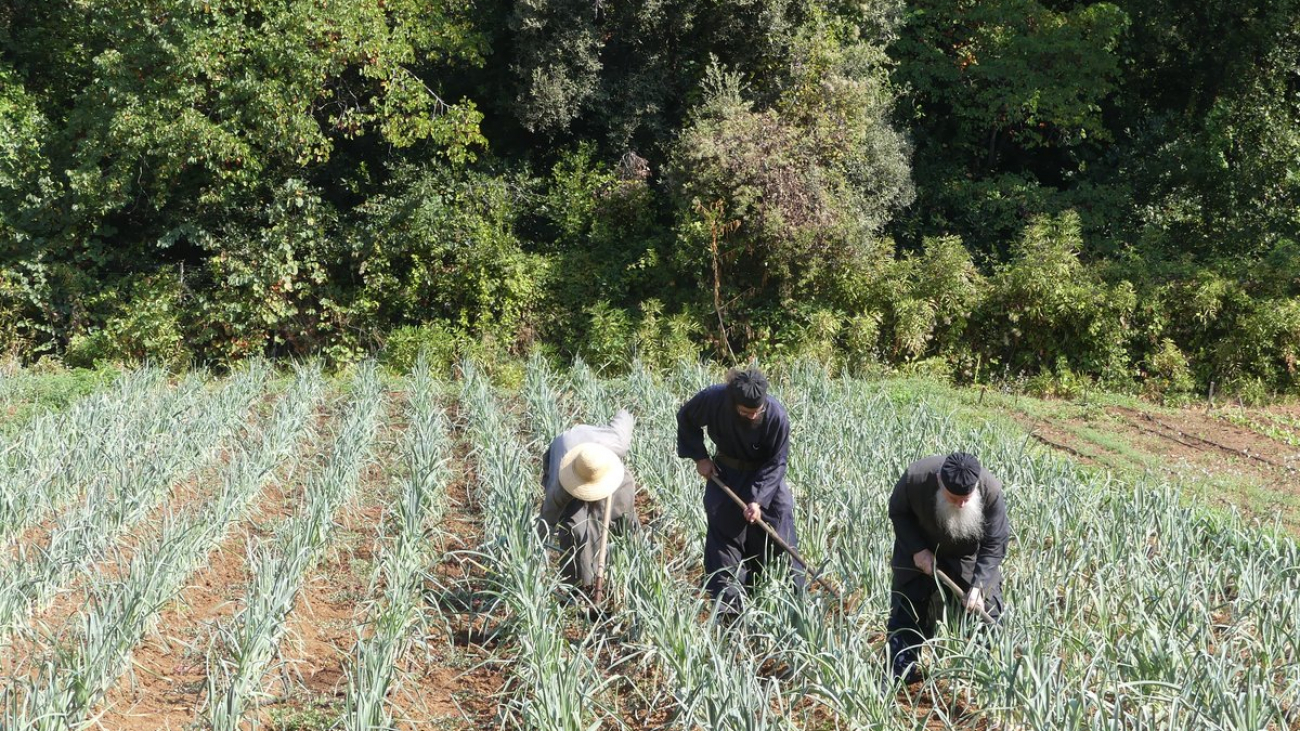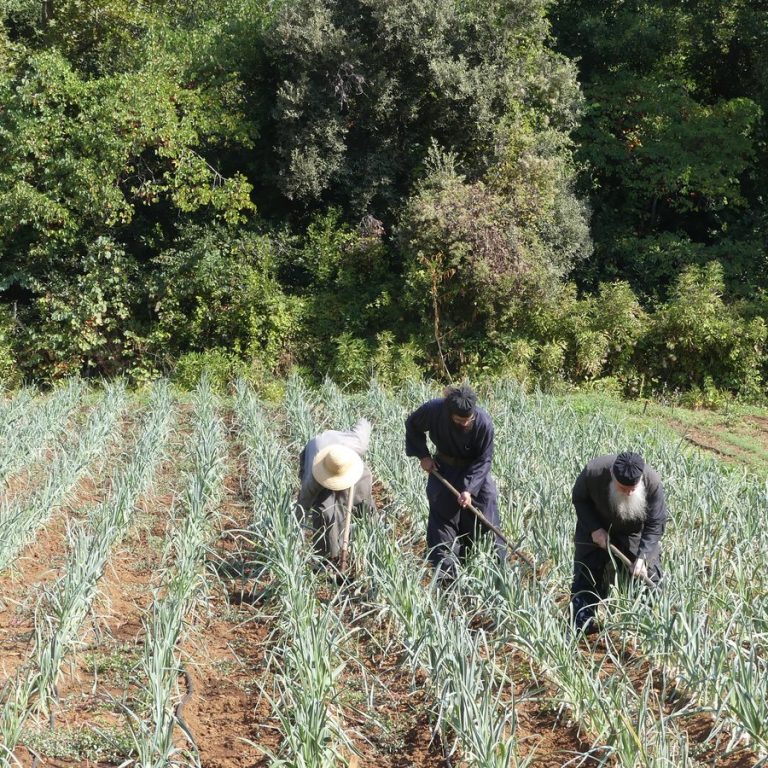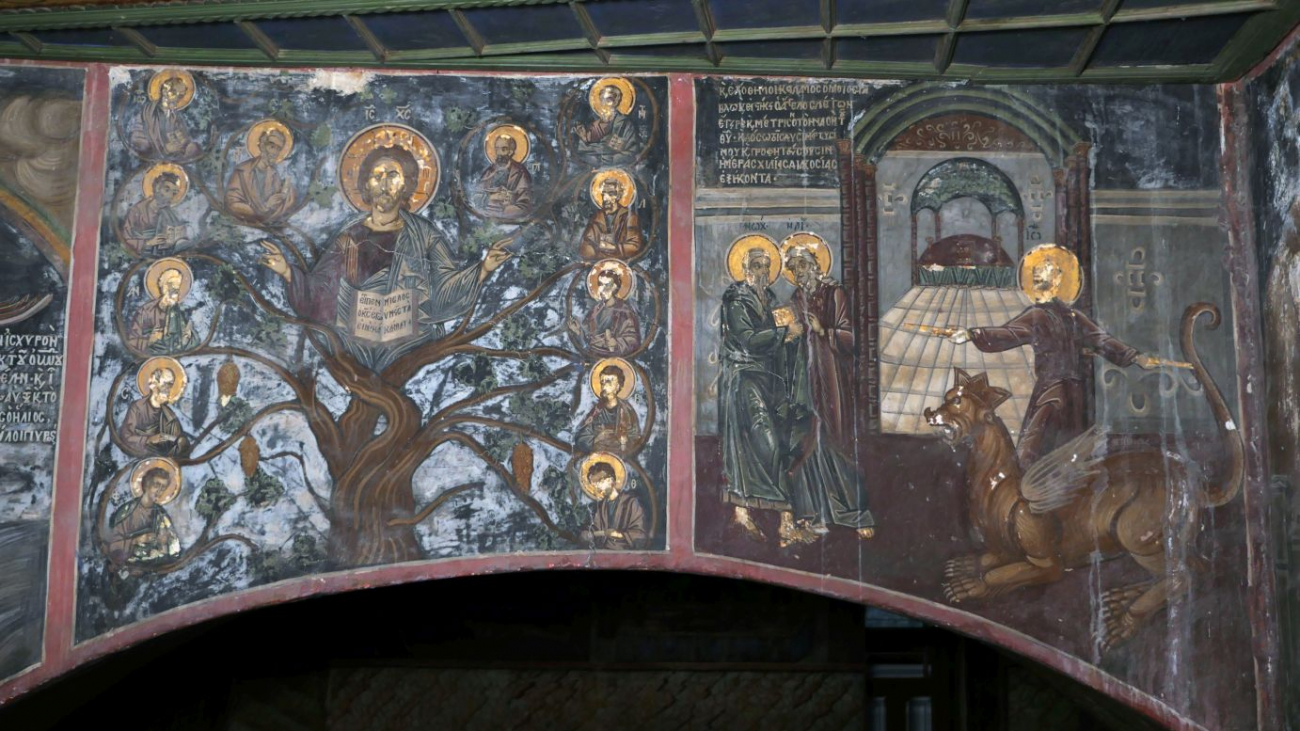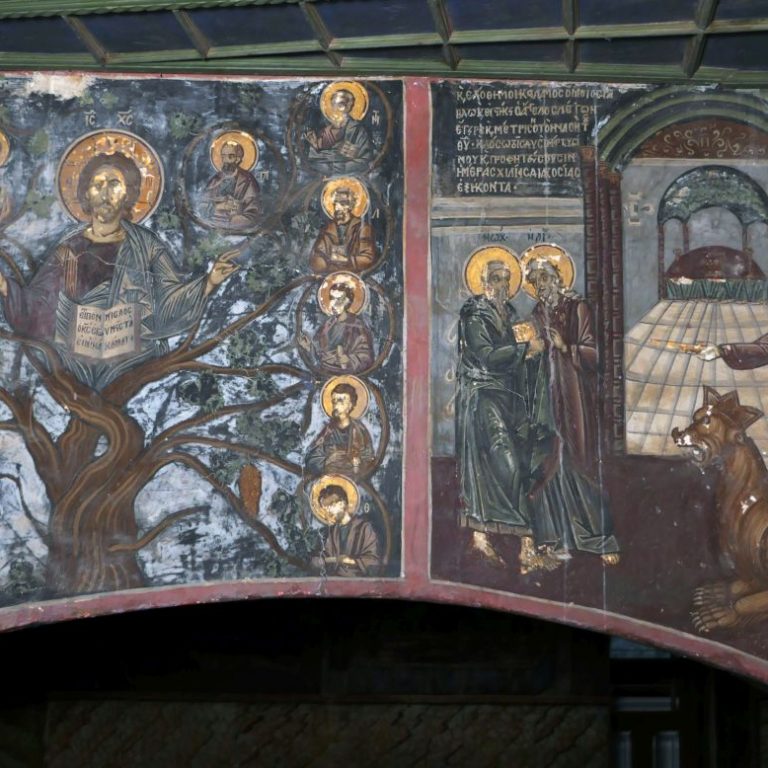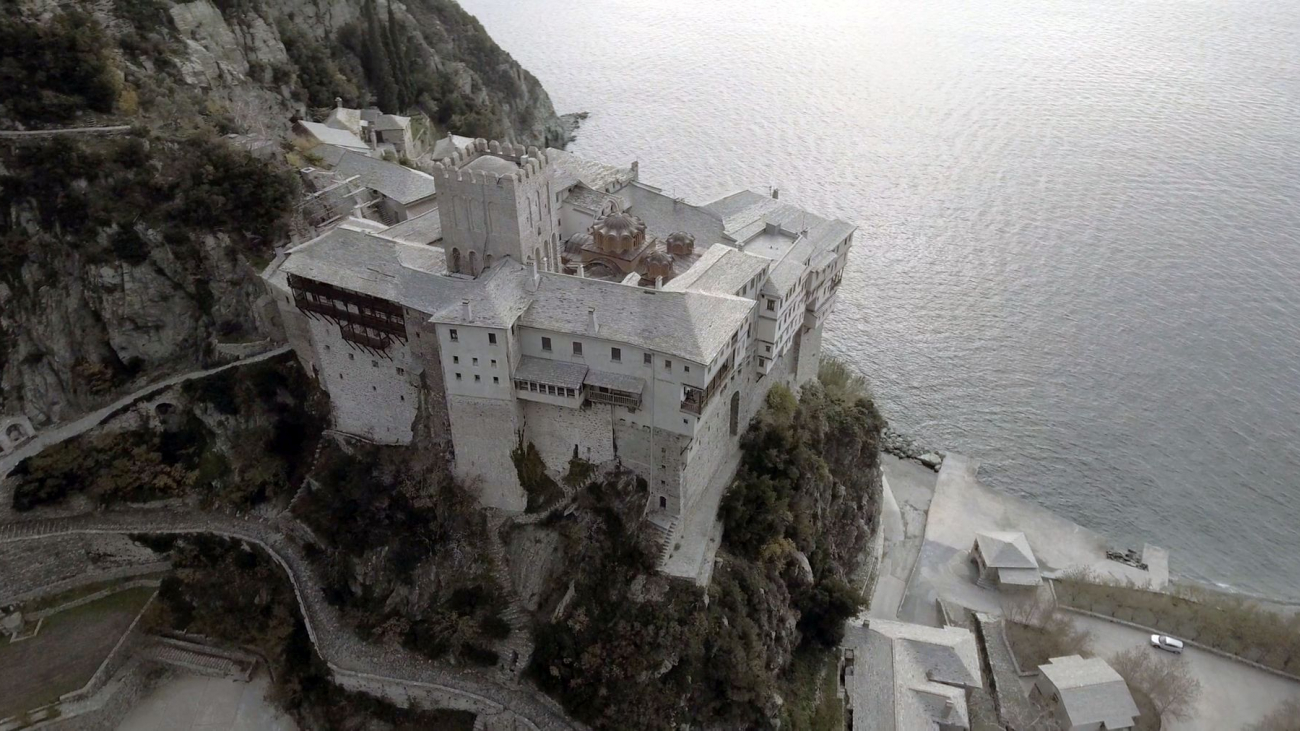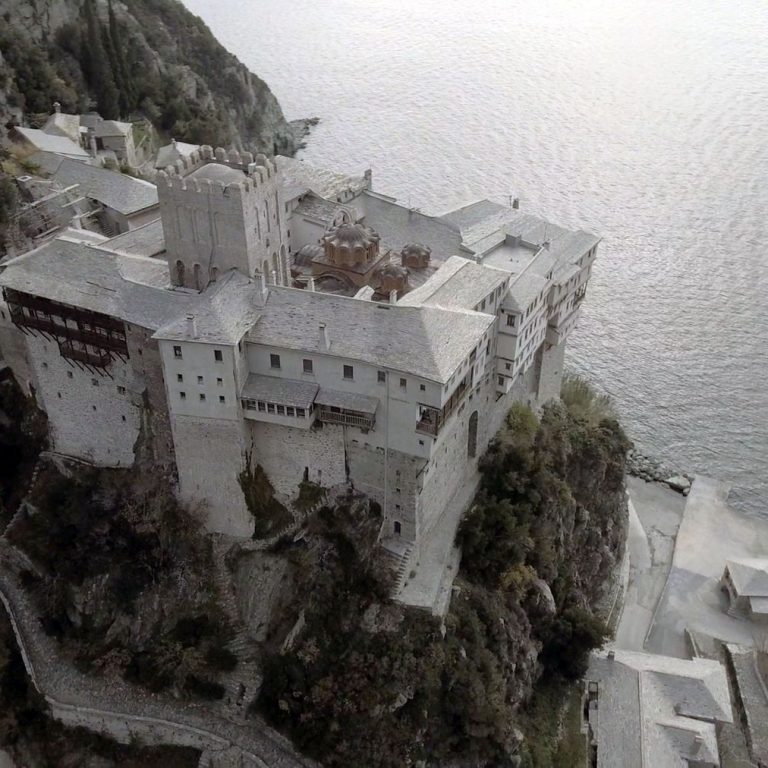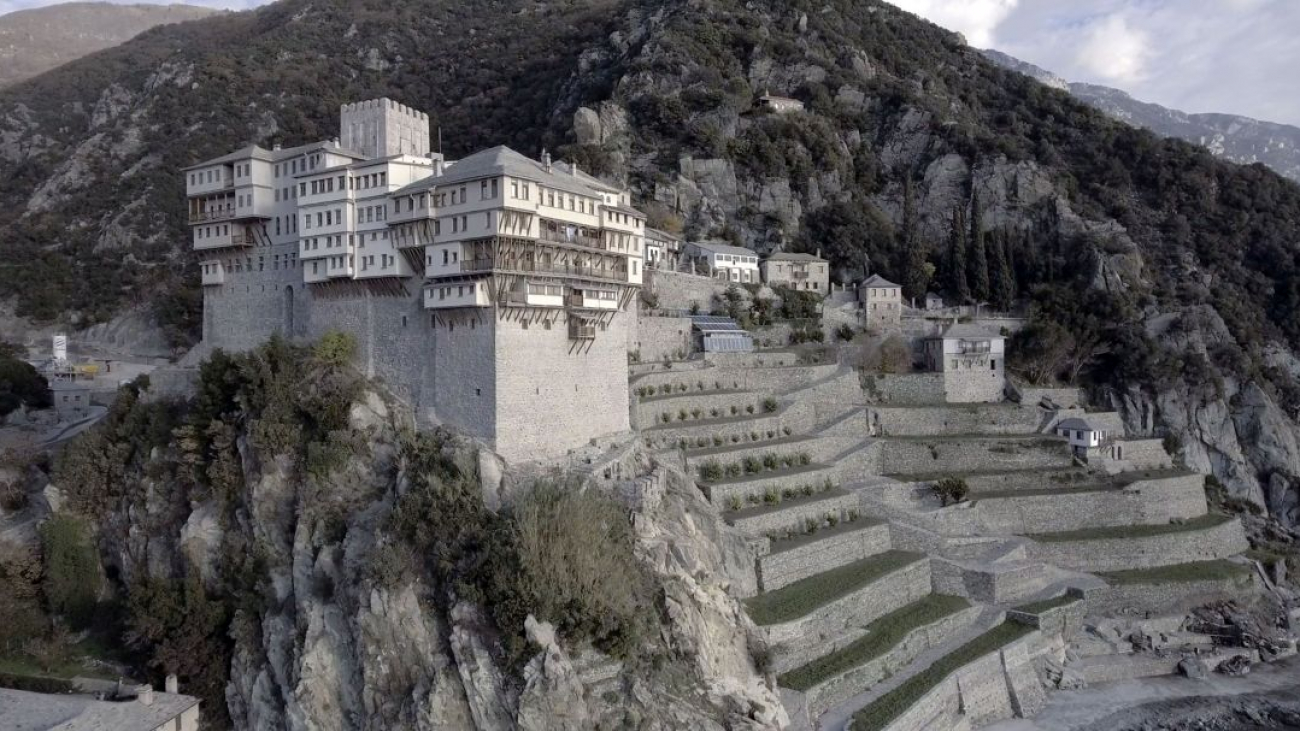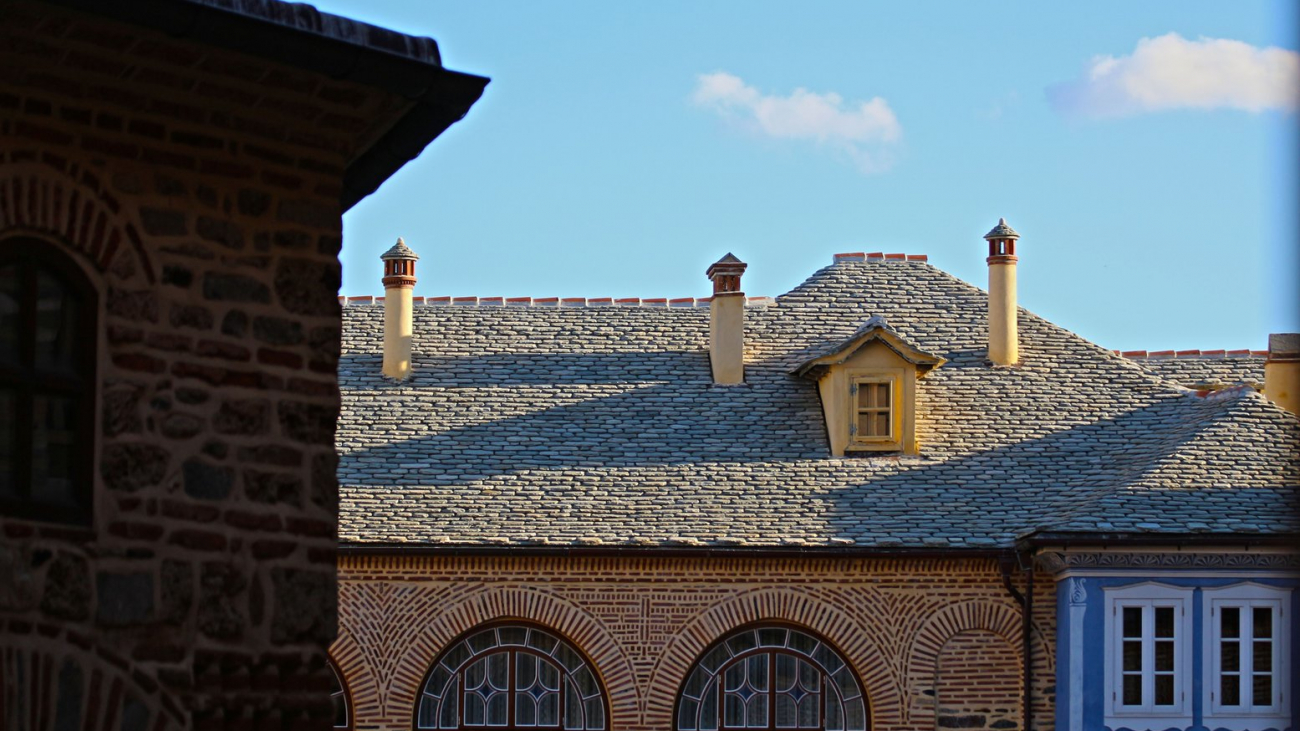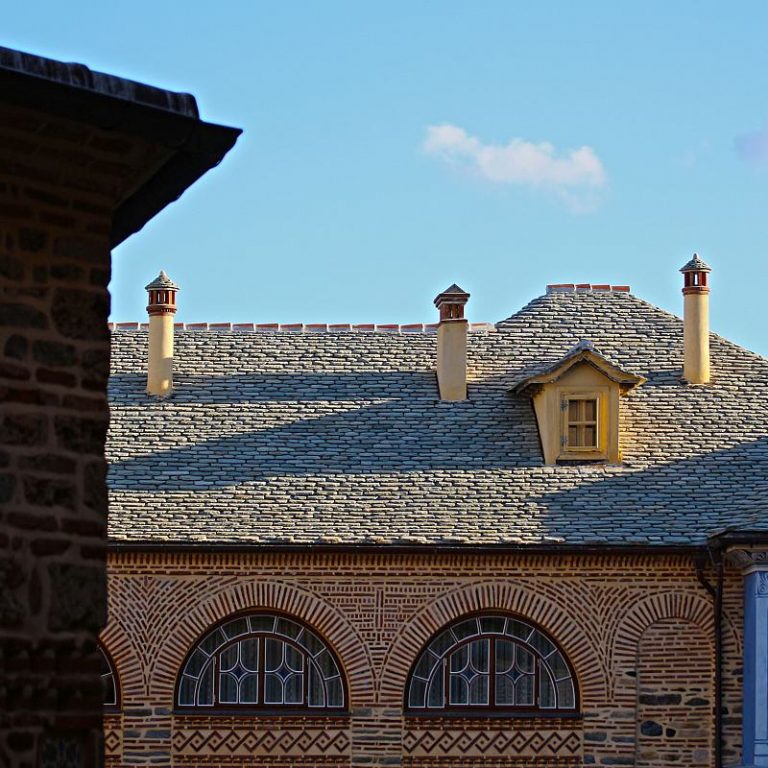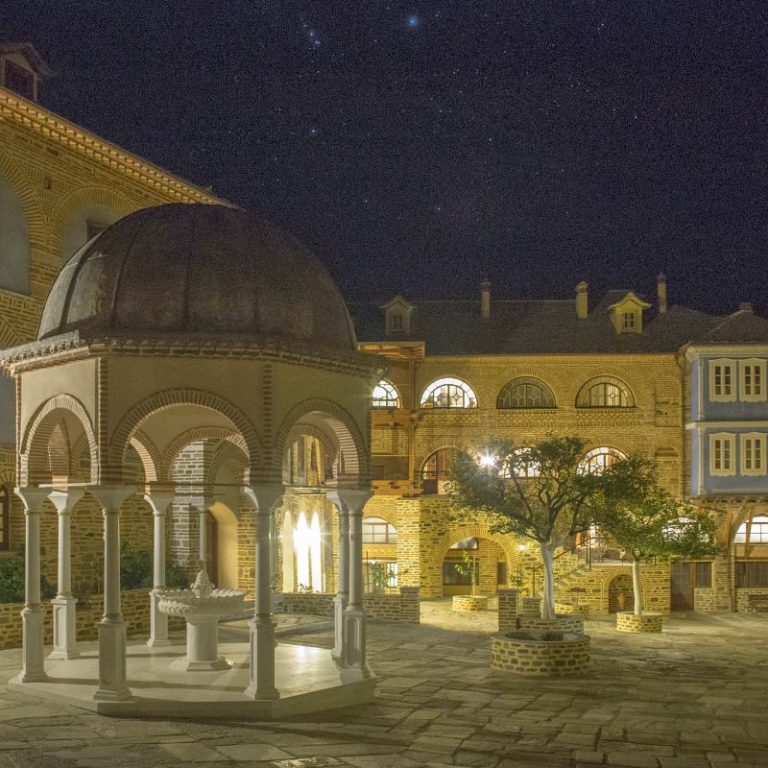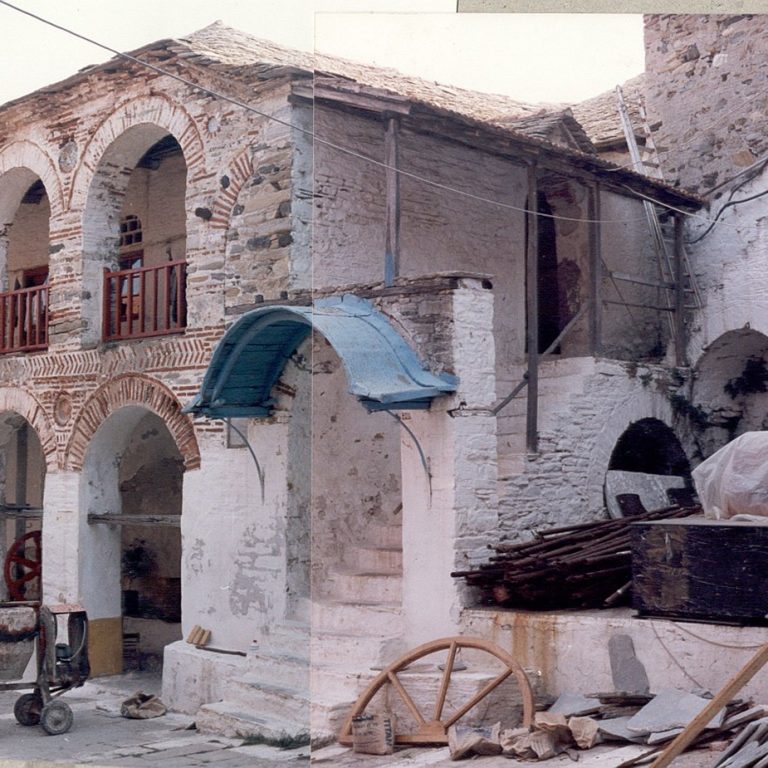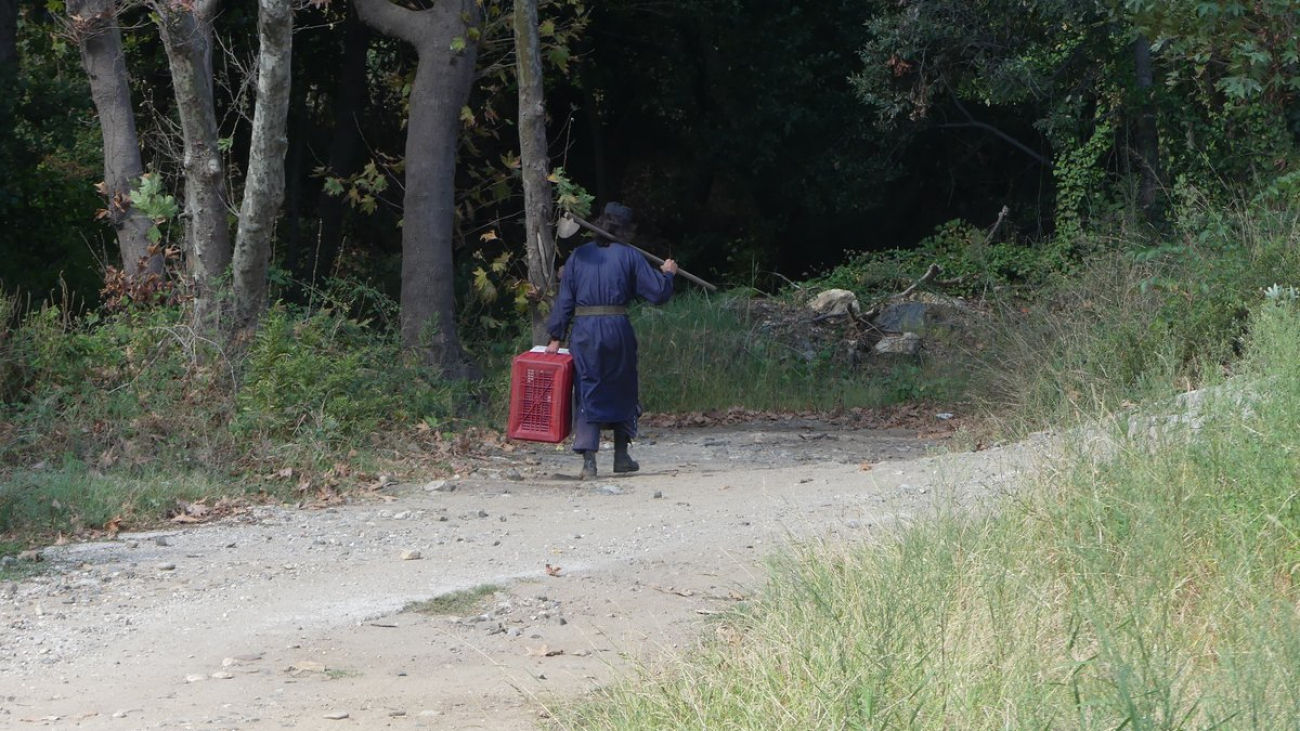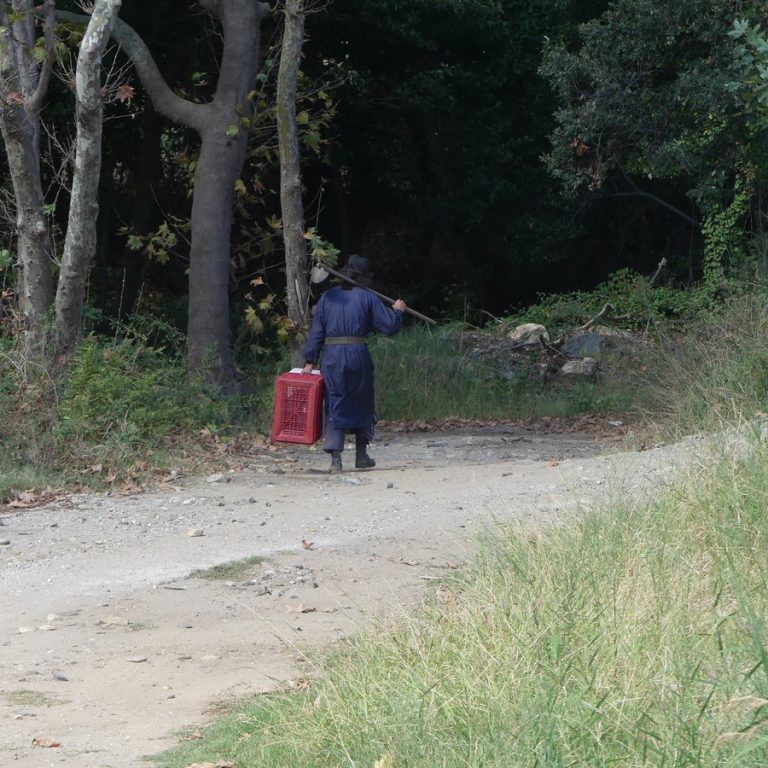The Library
The Library of the Monastery contains about 450 manuscripts and more than 3,500 printed books, and is housed today on the second floor of the renovated tower.
A bibliographic workshop functioned in the Monastery almost immediately after its founding, a fact which is confirmed by the uniquely designed niches in the tower, which facilitate the work of a cataloguer. The Library operated both systematically and sporadically, depending on the historical situation. During the 16th century, in the Monastery's Καλύβη (Kalyvi, a dependent, ascetic monastic community) of St Vasilieos in Kapsala, the work of the Library was conducted by St Theofilos the Myrovlytis (μyrovlytis denotes a saint whose relics miraculously emit the sweet aroma of myrrh) during the last period of his life.
Today, the library has a collection of quite rare, important, and exceptionally well-crafted Byzantine and post-Byzantine manuscripts, including 68 parchment codices, as well as three parchment scrolls of the 14th century, and three silk codices. The collection also contains nine Arabic manuscripts and several Romanian music codices. The following are of particular interest:
a) The parchment Book of Psalms no. 61, one of the rare (only three still survive today) illustrated Psalters of the iconoclastic period (the first half of the 9th century), with palimpsest text and 97 brief notations in the margins of the pages and themes from the Old and New Testaments, represented in an early form of iconoclastic Byzantine art characterized by a great amount of freedom of artistic expression,
b) The parchment Codice 234, known as The Gospel of St John of Kalyvitos (11th century), an exceptional-quality illustrated manuscript with a varied content and unique notations with scenes of the Evangelists and other saints. This manuscript is mentioned as being among the 'renowned relics of Mt Athos' by the well-known scholar and monk of Xeropotamnos Monastery Caesarios Dapontes in his work The Garden of Graces:
'Within the Monastery of the Almighty now is the Gospel there for all time, / the famous one from Kalyvitos / [the Gospel] of John, as he is called, / together with his blessings to us.'
This codice, which was given much attention by the English traveller R. Curzon in 1837, was stolen in 1898, but located a short time later in Athens and returned to the Monastery, an event which the tradition of the Monastery links with the miraculous intervention of St Minas.
c) The parchment Ευαγγελιστάριο (Evangelistario, 'Lectionary') no. 10, which dates to the 12th century and is decorated with artistic, flourished titles and initial letters (literae florissae).
d) The parchment Τετραευάγγελο (Tetraevangelo, The Four Gospels) no. 47, decorated in 1301 with depictions of the Evangelists, is the work of the famous Thessalonikan calligrapher Theodoros Agiopetritis.
e) The Codice no. 251 of the 14th century, which includes many of the works of the well-known cloistered theologian Iosef Kalothetis, who was referenced by St Nikodimos in his work The Garden of Graces: 'Iosef Kolothetis … had books of his own, which are saved in the Sacred and Patriarchial Monastery Pantokratoros.'
f) The Codice no. 127 (from the 15th century), the work of Patriarch Gennadios of Scholarios, written in his own hand.
g) The Codice No. 284 (from the end of the 15th century), which includes the six Canons for the feast of the Transfiguration, which was written by the famous scholar Mathaios Kamariotis especially for the Monastery.
h) The Codice No. 140, the only surviving manuscript of the poems of the Cretan poet Leonardos Dellaportas (15th century).
I) The Codice No. 85 (1538), The Register of the Saints whose feasts are celebrated during the months of September-February, which was copied by St Theofilos of Pantocrator Monastery, and which St Nikodimos the Athonite used as a primary basis in the writing of his monumental work of the same name, as he himself admits in the Prologue,
'I went down to the holy, respected, and patriarchal monastery Pantokratoros, among whose mountains I live, and take [responsibility for] the manuscript for this Register, in two volumes, narrated, decorated and written by the hand of an unworthy being.'
j) The Liturgical Codice no. 226, written by the well-known author, composer of hymns and codicil writer of the 17th century Mathaios Myreos, and dedicated 'to the holy and respected and patriarchial monastery of Pancratoras, on the sacred mountain of Athos' in 1624, and
k) The uncategorized Codice no. 13, by St Nikodimos the Athonite and written in his own hand, which bears the inscription,
Rule: The new octave for the Presentation of our Lady the Virgin Mary, to be sung every Saturday.
and was written at the request of the fathers at the Chilandarios Monastery, whose cathedral is dedicated to the feast of the Presentation.
Over time, the library suffered various losses, such as the serious damages caused by the Revolution of 1821, and the practice of the seizure of documents by others, which resulted in a significant number of important manuscripts lost through their incorporation into the collections of libraries abroad. A characteristic example is the case of the Russian Arsenios Souchanof: In the middle of the 17th century, Souchanof, while on a mission to Agios Oros supported by the Tsar and the Patriarch of Moscow, removed hundreds of precious codices from the libraries of virtually all the Athonite monasteries, among them 31 very valuable manuscripts from the Pantocratoras. These codices, together with the other codices taken from the Athonite community, comprise the largest part of the collection of the Synodic Library of Moscow (today called the History Museum).
The Codices 48, 49, and 69, which today are found in the collection of the Byzantine Institute of Dumbarton Oaks in Washington, come from the Library of the Pantokratoros, while the guidelines of the Pantokratoros cataloguer Ignatios now belong – in whole or in part – to the Vatican Library.
A bibliographic workshop functioned in the Monastery almost immediately after its founding, a fact which is confirmed by the uniquely designed niches in the tower, which facilitate the work of a cataloguer. The Library operated both systematically and sporadically, depending on the historical situation. During the 16th century, in the Monastery's Καλύβη (Kalyvi, a dependent, ascetic monastic community) of St Vasilieos in Kapsala, the work of the Library was conducted by St Theofilos the Myrovlytis (μyrovlytis denotes a saint whose relics miraculously emit the sweet aroma of myrrh) during the last period of his life.
Today, the library has a collection of quite rare, important, and exceptionally well-crafted Byzantine and post-Byzantine manuscripts, including 68 parchment codices, as well as three parchment scrolls of the 14th century, and three silk codices. The collection also contains nine Arabic manuscripts and several Romanian music codices. The following are of particular interest:
a) The parchment Book of Psalms no. 61, one of the rare (only three still survive today) illustrated Psalters of the iconoclastic period (the first half of the 9th century), with palimpsest text and 97 brief notations in the margins of the pages and themes from the Old and New Testaments, represented in an early form of iconoclastic Byzantine art characterized by a great amount of freedom of artistic expression,
b) The parchment Codice 234, known as The Gospel of St John of Kalyvitos (11th century), an exceptional-quality illustrated manuscript with a varied content and unique notations with scenes of the Evangelists and other saints. This manuscript is mentioned as being among the 'renowned relics of Mt Athos' by the well-known scholar and monk of Xeropotamnos Monastery Caesarios Dapontes in his work The Garden of Graces:
'Within the Monastery of the Almighty now is the Gospel there for all time, / the famous one from Kalyvitos / [the Gospel] of John, as he is called, / together with his blessings to us.'
This codice, which was given much attention by the English traveller R. Curzon in 1837, was stolen in 1898, but located a short time later in Athens and returned to the Monastery, an event which the tradition of the Monastery links with the miraculous intervention of St Minas.
c) The parchment Ευαγγελιστάριο (Evangelistario, 'Lectionary') no. 10, which dates to the 12th century and is decorated with artistic, flourished titles and initial letters (literae florissae).
d) The parchment Τετραευάγγελο (Tetraevangelo, The Four Gospels) no. 47, decorated in 1301 with depictions of the Evangelists, is the work of the famous Thessalonikan calligrapher Theodoros Agiopetritis.
e) The Codice no. 251 of the 14th century, which includes many of the works of the well-known cloistered theologian Iosef Kalothetis, who was referenced by St Nikodimos in his work The Garden of Graces: 'Iosef Kolothetis … had books of his own, which are saved in the Sacred and Patriarchial Monastery Pantokratoros.'
f) The Codice no. 127 (from the 15th century), the work of Patriarch Gennadios of Scholarios, written in his own hand.
g) The Codice No. 284 (from the end of the 15th century), which includes the six Canons for the feast of the Transfiguration, which was written by the famous scholar Mathaios Kamariotis especially for the Monastery.
h) The Codice No. 140, the only surviving manuscript of the poems of the Cretan poet Leonardos Dellaportas (15th century).
I) The Codice No. 85 (1538), The Register of the Saints whose feasts are celebrated during the months of September-February, which was copied by St Theofilos of Pantocrator Monastery, and which St Nikodimos the Athonite used as a primary basis in the writing of his monumental work of the same name, as he himself admits in the Prologue,
'I went down to the holy, respected, and patriarchal monastery Pantokratoros, among whose mountains I live, and take [responsibility for] the manuscript for this Register, in two volumes, narrated, decorated and written by the hand of an unworthy being.'
j) The Liturgical Codice no. 226, written by the well-known author, composer of hymns and codicil writer of the 17th century Mathaios Myreos, and dedicated 'to the holy and respected and patriarchial monastery of Pancratoras, on the sacred mountain of Athos' in 1624, and
k) The uncategorized Codice no. 13, by St Nikodimos the Athonite and written in his own hand, which bears the inscription,
Rule: The new octave for the Presentation of our Lady the Virgin Mary, to be sung every Saturday.
and was written at the request of the fathers at the Chilandarios Monastery, whose cathedral is dedicated to the feast of the Presentation.
Over time, the library suffered various losses, such as the serious damages caused by the Revolution of 1821, and the practice of the seizure of documents by others, which resulted in a significant number of important manuscripts lost through their incorporation into the collections of libraries abroad. A characteristic example is the case of the Russian Arsenios Souchanof: In the middle of the 17th century, Souchanof, while on a mission to Agios Oros supported by the Tsar and the Patriarch of Moscow, removed hundreds of precious codices from the libraries of virtually all the Athonite monasteries, among them 31 very valuable manuscripts from the Pantocratoras. These codices, together with the other codices taken from the Athonite community, comprise the largest part of the collection of the Synodic Library of Moscow (today called the History Museum).
The Codices 48, 49, and 69, which today are found in the collection of the Byzantine Institute of Dumbarton Oaks in Washington, come from the Library of the Pantokratoros, while the guidelines of the Pantokratoros cataloguer Ignatios now belong – in whole or in part – to the Vatican Library.


